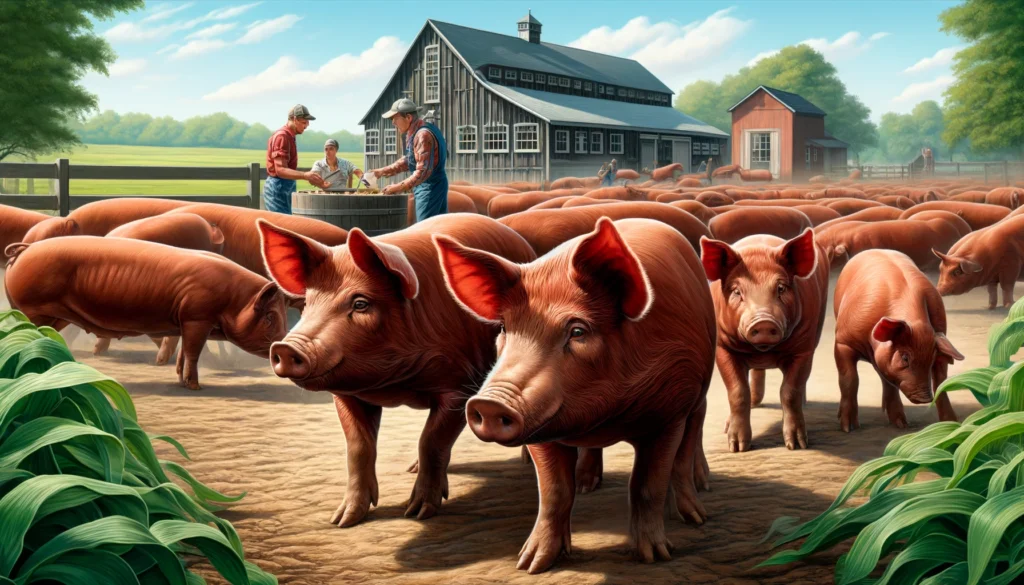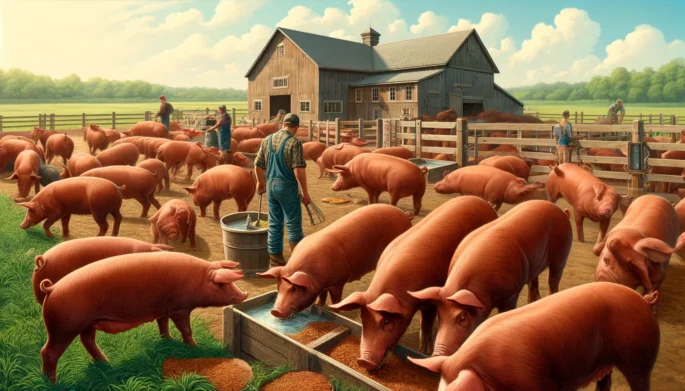Farming Duroc Hogs: A Comprehensive Guide
Introduction to Duroc Hogs
Farming Duroc hogs is a rewarding endeavor for both small-scale farmers and large agricultural enterprises. Known for their excellent meat quality, fast growth, and hardy nature, Duroc hogs are a popular choice in the swine industry. This guide provides a thorough overview of the essential aspects of farming Duroc hogs, including their history, characteristics, breeding, feeding, health management, and marketing.
History and Characteristics of Duroc Hogs
Origin and Development
The Duroc breed originated in the United States during the early 19th century. It is believed that the breed was developed by crossing Old Duroc hogs from New York with Jersey Reds from New Jersey. The resulting breed exhibited superior traits, making it a favorite among hog farmers.
Physical Characteristics
Duroc hogs are easily recognizable by their reddish-brown color, which can range from a light golden shade to a deep mahogany. They have a medium length, a slightly arched back, and drooping ears. Adult Duroc boars typically weigh between 800 to 1,000 pounds, while sows weigh between 600 to 800 pounds. These hogs are known for their muscular build and excellent meat quality, characterized by marbling and tenderness.
Breeding and Reproduction
Selecting Breeding Stock
Choosing the right breeding stock is crucial for a successful Duroc hog farming operation. Look for animals with strong, sturdy legs, a straight back, and a good overall body condition. It’s also essential to select hogs with a calm temperament and good mothering abilities.
Mating and Gestation
Duroc sows have a gestation period of approximately 114 days. It’s important to provide them with a comfortable and stress-free environment during this time. Adequate nutrition and access to clean water are vital for the health of the sow and her piglets.
Farrowing and Piglet Care
Farrowing, the process of giving birth, requires careful management to ensure the health and survival of the piglets. Create a clean and warm farrowing pen for the sow. Piglets should be monitored closely for the first few days to ensure they are nursing properly and receiving adequate colostrum.
Feeding and Nutrition
Nutritional Requirements
Duroc hogs require a balanced diet to support their growth and overall health. Their diet should include a mix of proteins, carbohydrates, fats, vitamins, and minerals. Corn and soybean meal are commonly used as the primary ingredients in hog feed.
Feeding Stages
The nutritional needs of Duroc hogs change as they grow. Piglets should be provided with a starter feed high in protein to support rapid growth. As they transition to the grower stage, the protein content can be gradually reduced. Finishers, or hogs nearing market weight, require a diet that promotes muscle development and fat deposition.
Water Supply
Access to clean and fresh water is crucial for the health of Duroc hogs. Ensure that waterers are cleaned regularly and that hogs can easily access them at all times.
Housing and Environment
Housing Requirements
Duroc hogs require adequate housing to protect them from extreme weather conditions and to provide a comfortable living environment. Housing should be well-ventilated, dry, and spacious enough to allow for natural behaviors such as rooting and wallowing.
Bedding and Maintenance
Use straw, wood shavings, or other suitable bedding materials to keep the housing area dry and clean. Regularly remove soiled bedding and replace it with fresh material to prevent the buildup of harmful bacteria and parasites.
Health Management
Common Health Issues
Duroc hogs, like all livestock, are susceptible to various health issues. Some common ailments include respiratory diseases, gastrointestinal disorders, and skin infections. Regular health checks and vaccinations are essential to prevent and manage these conditions.
Vaccination and Biosecurity
Implementing a vaccination program is crucial for protecting Duroc hogs from common diseases such as swine flu, porcine reproductive and respiratory syndrome (PRRS), and foot-and-mouth disease. Additionally, maintaining biosecurity measures, such as controlling visitor access and disinfecting equipment, helps prevent the introduction of pathogens to the farm.
Parasite Control
Internal and external parasites can significantly impact the health and productivity of Duroc hogs. Regular deworming and the use of insecticides can help control parasite infestations. It’s also important to keep the housing area clean and to rotate pastures to reduce the risk of parasite buildup.
Marketing and Economics
Market Demand and Trends
Duroc hogs are highly sought after for their superior meat quality, which commands a premium price in the market. Understanding market trends and consumer preferences can help farmers make informed decisions about breeding and marketing strategies.
Direct Marketing
Selling Duroc pork directly to consumers can be a profitable venture. Farmers can establish a loyal customer base by promoting the unique qualities of Duroc pork, such as its marbling, tenderness, and flavor. Farmers’ markets, farm-to-table restaurants, and online sales platforms are excellent avenues for direct marketing.
Wholesale and Retail Opportunities
Wholesale markets, such as supermarkets and meat processors, offer another viable option for selling Duroc pork. Building relationships with local retailers and processors can help secure consistent sales and expand market reach.
Environmental Sustainability
Sustainable Farming Practices
Adopting sustainable farming practices is essential for the long-term success of a Duroc hog farming operation. These practices include crop rotation, cover cropping, and integrated pest management. Reducing reliance on chemical inputs and promoting soil health can enhance the sustainability of the farm.
Waste Management
Proper waste management is crucial for minimizing the environmental impact of hog farming. Implementing systems for composting manure and utilizing it as fertilizer can improve soil fertility and reduce the risk of water contamination.
Economic Considerations
Initial Investment
Starting a Duroc hog farming operation requires a significant initial investment. Costs include purchasing breeding stock, building housing facilities, and acquiring feed and equipment. Creating a detailed business plan and budget can help farmers manage these expenses effectively.
Operating Costs
Operating costs, such as feed, veterinary care, and labor, are ongoing expenses that must be carefully managed. Implementing cost-saving measures, such as bulk purchasing and efficient feed management, can help reduce operating costs and improve profitability.
Financial Assistance and Grants
Various government programs and agricultural organizations offer financial assistance and grants to support hog farmers. Researching and applying for these programs can provide valuable resources for expanding and improving the farming operation.
Challenges and Solutions
Disease Outbreaks
Disease outbreaks can devastate a hog farming operation. Implementing strict biosecurity measures, maintaining proper hygiene, and regularly monitoring the health of the herd are essential for preventing and managing disease outbreaks.
Market Fluctuations
Market fluctuations can impact the profitability of hog farming. Diversifying income streams, such as offering value-added products or agritourism experiences, can help mitigate the effects of market volatility.
Labor Shortages
Labor shortages can pose a significant challenge for hog farmers. Investing in labor-saving technologies, such as automated feeding systems and climate control equipment, can help reduce the reliance on manual labor.
Case Studies and Success Stories
Small-Scale Farm Success
Jane Smith, a small-scale hog farmer in Iowa, started her Duroc hog farming operation with just a few breeding sows. By focusing on direct marketing and building a loyal customer base, she has successfully grown her business and now supplies high-quality Duroc pork to local restaurants and farmers’ markets.
Large-Scale Farm Success
The Johnson Family Farm, a large-scale operation in Nebraska, has been farming Duroc hogs for over 30 years. Through careful breeding selection, efficient feed management, and sustainable farming practices, they have established a reputation for producing top-quality pork. Their farm supplies major retailers and processors, ensuring a steady income stream.
Future Trends in Duroc Hog Farming
Genetic Improvements
Advancements in genetic research are likely to play a significant role in the future of Duroc hog farming. Selective breeding programs focusing on traits such as growth rate, feed efficiency, and disease resistance can enhance the overall productivity and profitability of the breed.
Technology Integration
The integration of technology in hog farming, such as precision feeding systems and health monitoring devices, can improve efficiency and animal welfare. These technologies allow farmers to make data-driven decisions and optimize their operations.
Consumer Preferences
As consumers become more conscious of the origin and quality of their food, there is a growing demand for ethically raised and sustainably produced pork. Farmers who prioritize animal welfare and environmental sustainability are well-positioned to meet this demand and command premium prices for their products.
Conclusion
Farming Duroc hogs offers numerous opportunities for success, whether you are a small-scale farmer or a large agricultural enterprise. By understanding the breed’s characteristics, implementing best practices in breeding, feeding, and health management, and staying attuned to market trends and consumer preferences, farmers can achieve a profitable and sustainable operation. Embracing technological advancements and sustainable farming practices will further enhance the efficiency and environmental stewardship of Duroc hog farming.
Resources and Further Reading
- National Swine Registry (NSR): www.nationalswine.com
- American Duroc Association: www.durocpigbreeders.com
- University of Minnesota Extension: Swine production resources
- Pork Checkoff: www.pork.org
By utilizing these resources and applying the knowledge gained from this guide, farmers can successfully navigate the challenges and opportunities of farming Duroc hogs, ensuring a prosperous and sustainable future in the swine industry.

